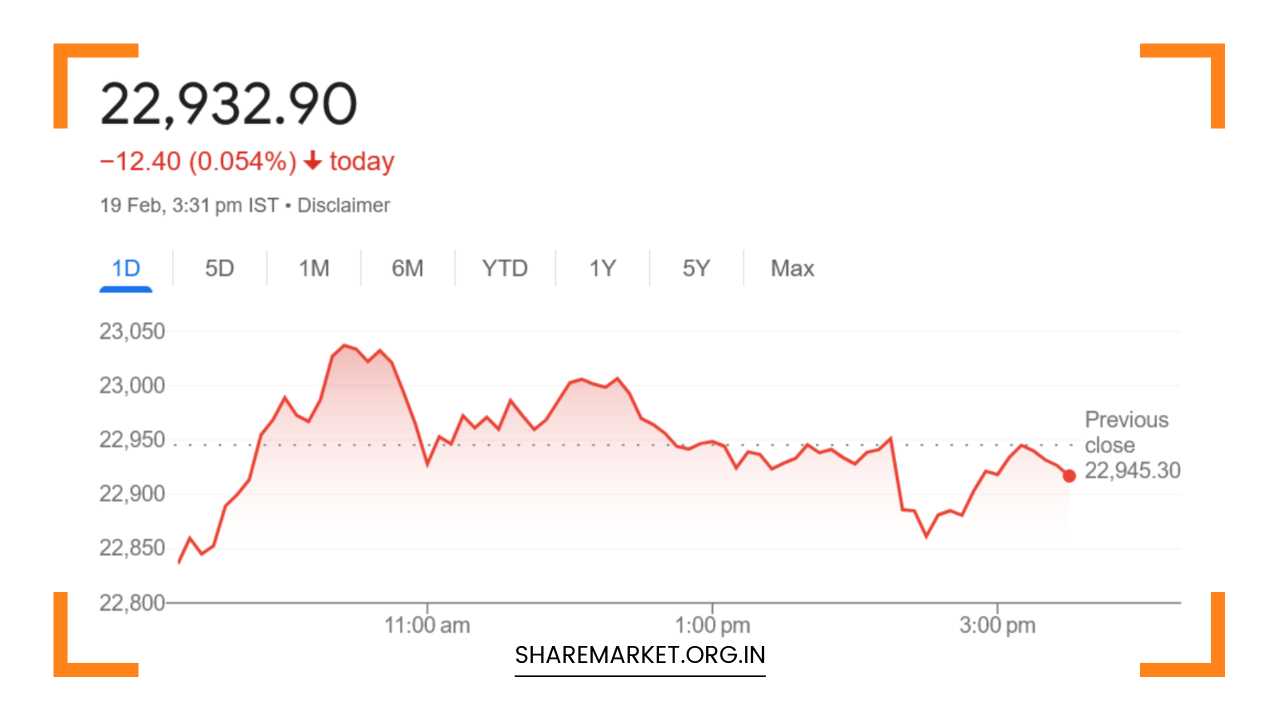Sensex Down 28 Points, Nifty at 22,932; Tomorrow Nifty Prediction

Tomorrow Nifty Prediction
Market Closes Flat After High Volatility: Key Insights for February 20
Market Overview: The Indian stock market closed with minor losses on February 19, continuing its downward trend for the fourth consecutive trading day.
Despite significant volatility throughout the session, the market remained largely range-bound, as investors exercised caution amid growing concerns over global economic factors.
The Nifty index ended slightly lower at 22,932.90, down by 12.40 points or 0.05%, while the Sensex declined by 28.21 points or 0.04%, closing at 75,939.18.
The day saw significant fluctuations, with the market initially showing signs of recovery before retreating again.
This sharp volatility reflected mixed sentiment among market participants, who were digesting the latest developments in global trade relations and awaiting upcoming economic data.
Notably, the market remained range-bound, with investors holding off on making large directional bets until more clarity emerges from external cues such as the minutes of the Federal Open Market Committee (FOMC) meeting.
Sector Performance:
The session revealed a notable divergence in sectoral performance. While sectors like realty and media showed resilience and performed well, other heavyweight sectors such as IT and pharma came under pressure.
The IT sector, which has been a key driver of the Indian market in recent years, witnessed a decline of 1.3%, marking a challenging day for some of the sector’s largest players.
Meanwhile, the pharmaceutical sector also faced a 0.7% dip, contributing to the overall decline in the market.
On the positive side, the realty and media sectors posted strong gains, outperforming the broader market.
These sectors saw an uptick of 1-2%, benefiting from a mix of investor interest and specific company developments. Among other outperforming sectors were energy, metal, PSU banks, and capital goods, which collectively added to the market’s positive momentum.
The market’s broader indices also showed positive signs. The BSE Midcap index rose by 1.3%, while the Smallcap index outperformed with a notable 2.4% gain.
This outperformance in the mid and small-cap segments suggests that some parts of the market are still finding opportunities despite broader market weakness.
These gains in mid and small-cap stocks may indicate a shift in investor preference towards more value-oriented stocks, with market participants seeking opportunities outside the large-cap space.
Stock Movers:
Within the Nifty 50 index, there were clear winners and losers, with individual stocks driving the day’s performance.
Dr. Reddy’s Laboratories, TCS, Hindustan Unilever (HUL), Infosys, and Adani Enterprises were among the major losers, contributing to the overall drag on the market.
The IT sector’s decline was largely attributed to weakness in blue-chip stocks like TCS and Infosys, both of which struggled to maintain upward momentum.
On the flip side, several stocks from different sectors managed to outperform, with Bharat Electronics, Hindalco, L&T, Axis Bank, and Eicher Motors emerging as the top gainers.
These stocks benefited from positive sentiment within their respective sectors, with Hindalco and L&T standing out as notable performers due to strong price action.
The broader market also saw increased interest in mid and small-cap stocks, with certain companies in the energy, construction, and finance sectors gaining favor.
The BSE Midcap index gained 1.3%, and the Smallcap index posted an even more impressive gain of 2.4%, signaling that risk appetite may still exist among investors for smaller, undervalued stocks.
Global Developments and Investor Sentiment:
Investor sentiment remained cautious throughout the day, driven by concerns over global economic developments, particularly in the context of US trade policy.
The most significant external development that influenced market sentiment was US President Donald Trump’s announcement that he planned to impose 25% tariffs on auto, semiconductor, and pharmaceutical imports.
This potential escalation in trade tensions spooked investors and led to heightened uncertainty regarding global supply chains, international trade, and growth prospects.
With trade war fears resurfacing, global markets have been under pressure, and Indian stocks were not immune to this broader trend.
The prospect of a slowdown in global demand and the impact of tariffs on Indian exporters and the pharma sector, in particular, kept many investors on edge.
As a result, the Indian market largely moved within a narrow range, with cautious traders awaiting additional clarity on the potential impact of these trade developments.
Additionally, market participants were keeping a close watch on the upcoming release of the minutes from the latest Federal Open Market Committee (FOMC) meeting. Investors hoped to gain insights into the US Federal Reserve’s stance on interest rates and monetary policy.
The market had already been dealing with volatility due to concerns over global growth and inflation, and any indications of tighter monetary policy from the US could further impact risk appetite in emerging markets like India.
Market Prediction:
Despite the challenges and volatility of the past few sessions, the Indian market showed some signs of recovery, especially in mid and small-cap stocks. Aditya Gaggar, Director at Progressive Shares, noted that the market traded within a limited range during the session, indicating a possible consolidation phase.
Although the market started off slowly due to concerns about trade tensions, it witnessed an upward movement before facing resistance near the 23,050 mark.
Ultimately, the Nifty ended the day with a slight decline, but it remained well within the established range of 22,800 to 23,100.
Gaggar emphasized that the market is currently waiting for a breakout from this range to determine its next direction.
The current range-bound movement indicates that investors are looking for a decisive catalyst, whether on the upside or downside, to trigger a strong trend in either direction.
Rupak Dey of LKP Securities further pointed out that Nifty’s support remains at the 22,800 level. As long as the index holds above this level, the market is unlikely to witness a major correction.
However, a decisive fall below 22,800 could open the door to a larger market correction. On the upside, resistance is likely to be encountered around the 23,000 and 23,150 levels. A breakout above 23,150 could trigger fresh momentum and push the market higher.
Key Levels to Watch:
- Support: 22,800
- Resistance: 23,000-23,150
- Market Direction: A break above 23,150 could lead to a fresh rally, while a drop below 22,800 could set the stage for a significant correction.
Final Remarks:
The market remains in a state of flux, with short-term volatility likely to persist until investors gain clarity on global trade developments and US monetary policy.
The Nifty continues to trade within a narrow range, and while mid and small-cap stocks are showing strength, the broader market is awaiting a breakout.
Key levels of support and resistance will be crucial in determining the next direction for the market, and investors should remain cautious but vigilant for any signs of a decisive trend.
As the global economic landscape evolves, the Indian market will likely continue to react to external cues, making it essential for traders to stay informed about developments in both domestic and international markets.

















